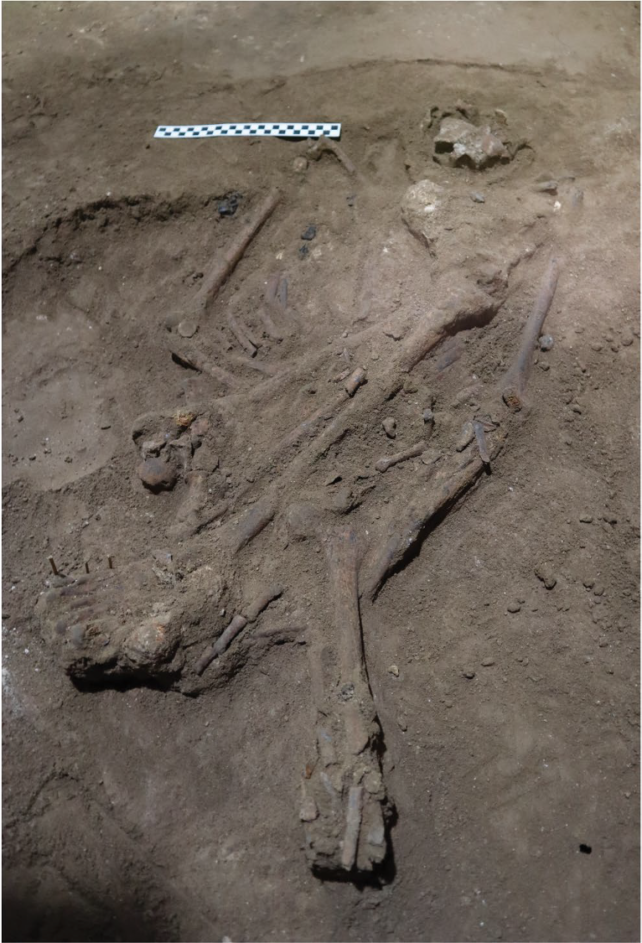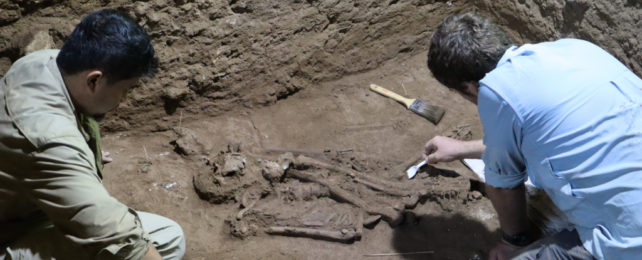Fossilized human remains, weathered by the elements and fragmented by earthly processes, are often missing body parts.
But the discovery of a human skeleton found in Indonesian Borneo missing its lower left leg has delighted scientists, who report the find is the oldest evidence of surgical amputation unearthed to date.
Uncovered in a limestone cave in a remote region of East Kalimantan in Indonesian Borneo, the skeleton was excavated in 2020 by a team of Indonesian and Australian researchers, co-led by archaeologist Tim Maloney of Griffith University.
On closer inspection, they discovered the young individual had had their left foot skillfully removed, probably as a child, at least 31,000 years ago.
Remarkably, it healed well enough for the person to live for another six to nine years before they were interred with their amputated leg outstretched and burial markers atop the grave.
"It was a huge surprise that this ancient forager survived a very serious and life-threatening childhood operation, that the wound healed to form a stump, and that they then lived for years in mountainous terrain with altered mobility – suggesting a high degree of community care," says bioarchaeologist Melandri Vlok of the University of Sydney.
Previously, the earliest evidence we had of Stone Age amputations was a 7,000-year-old skeleton found in France of an elderly male whose left forearm had been removed just above the elbow.
Even today, with a whole arsenal of medical products up doctors' sleeves to prevent infection, stop bleeding and dull pain, these operations require considerable technical skill and anatomical prowess.
Given medicine's gory history full of ghastly attempts to salvage fragile lives, the team has been marveling at the skills of the people who performed the operation, tens of thousands of years earlier than previously recorded – long before Western societies, who only managed to safely master such medical feats in the past 100 years or so.

Maloney and colleagues admit the discovery upends the prevailing assumption amongst archaeologists that more complex surgeries were beyond the abilities of foraging societies, both past and present.
As they report in their paper, the surgeon or team of practitioners must have had detailed knowledge of human anatomy, hygiene, and the body's circulatory systems to be able to navigate the veins, blood vessels, and nerves, amputate the foot, and prevent fatal blood loss and infection.
"They must also have understood the necessity to remove the limb for survival," the team writes.
It was previously thought that medical advances coincided with or followed the advent of agriculture, with the shift from foraging to farming in the last 10,000 years giving rise to a wave of health problems that prompted incremental gains in medical skills.
Earlier surgical amputations were thought to be only of fingers and only for ceremonial purposes or punishment.
"What the new finding in Borneo demonstrates is that humans already had the ability to successfully amputate diseased or damaged limbs long before we began farming and living in permanent settlements," says archaeologist Maxime Aubert of Griffith University.

Of course, dating ancient human remains can be tricky business. In this case, the researchers dated the skeleton by measuring trace levels of radiation preserved in its tooth enamel, which gave them an age estimate that matched the results of radiocarbon dating of the sediments the remains were buried in.
Tell-tale bony growths indicative of bone healing are what the researchers used to infer that the amputation likely occurred when the individual was a child, and they found no skeletal signs of infections where the leg bone was sliced clean across.
The team also hazard that the amputation probably wasn't caused by an animal attack or other kind of mishap because the blunt force of such accidents typically causes crushing fractures.
Whether the skeleton demonstrates an unusually advanced medical proficiency of foraging communities in this particular part of Borneo, or if it represents a more widespread and unrecognized knack for medical procedures amongst early humans, remains an open question – one that, perhaps, with more fossils, we'll learn more about.
It could, however, be a rare and isolated event. Although the rich knowledge that Indigenous peoples commonly have of plant-based remedies at least provides a means by which ancient humans in these rainforest parts of Asia could have treated infections.
"One possibility is that rapid rates of infection in the hot and humid tropics prompted early foragers in this region to tap into the rainforest's 'natural pharmacy' of medicinal plants, leading to an early flourishing in the use of botanical resources for anesthetics, antiseptics, and other wound-healing treatments," says archaeobotanist India Ella Dilkes-Hall of the University of Western Australia.
The research was published in Nature.
